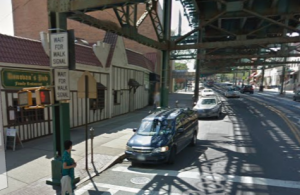
Roosevelt Avenue (Photo: Google Earth)
Feb. 21, 2014 By Christian Murray
The Department of Transportation plans to review the parking rules on Roosevelt Avenue between 50th and 59th Streets.
Currently, there are “no-parking” signs along that section of the Avenue between 4 pm and 7 pm on the east bound side of the street.
Business owners, such as Dan Connor and James Jacobson of Donovan’s Pub, have complained that many of their customers have been ticketed while frequenting their establishments after work.
They claim that tow trucks line up at 3:59 pm just waiting for their next victim—and that it’s just one big cash cow for the city.
“We continually hear complaints from business owners along Roosevelt Ave and it seems so unfair to the community and such a negative impact on businesses,” said Joe Conley, chairman of Community Board 2.
Conley presented the case to Queens DOT Commissioner Dalia Hall on Tuesday at Community Board 2’s monthly Transportation Committee meeting.
Hall said she would investigate whether the parking measures were necessary and recognized the complaints presented by the board on behalf of business owners were valid.
Conley said that the Roosevelt Ave is no longer viewed as the major thoroughfare of yesteryear. He said in recent years the idea has been to calm traffic down on Roosevelt Avenue for safety purposes and promote motorists using Queens Boulevard.
8 Comments







@nobody Thanks. Daylighting sounds like a good traffic calming measure for Roosevelt Ave.
Daylighting is removing the parking space 10 feet before the corner curb cut. This enables drivers to more easily see pedestrians (esp if there is an SUV parked there).
@nobody Can you clarify what you mean by “daylight the sidewalks”?
people park in the church’s parking lot for many years now that use to go to Donovan’s — or did they put a stop to that!!!!!!
It’s news to me that patrons drive to Donovan’s. Where on earth are they coming from? Seems like most people walk there.
We need less cars on the streets. Keep it as it is. And daylight the sidewalks around here for cryin’ out loud.
Does Deblasio know?
I agree Ben, it is horrible during rush hour. He has obviously seen the traffic during rush hour, but all he cares about are his pockets.
Has Conley ever seen Roosevelt Ave. during rush hour? There’s enough trouble with cars sitting with their emergency blinkers on so you have to go around them – imagine how bad it’s going to be if cars are parked there as well.